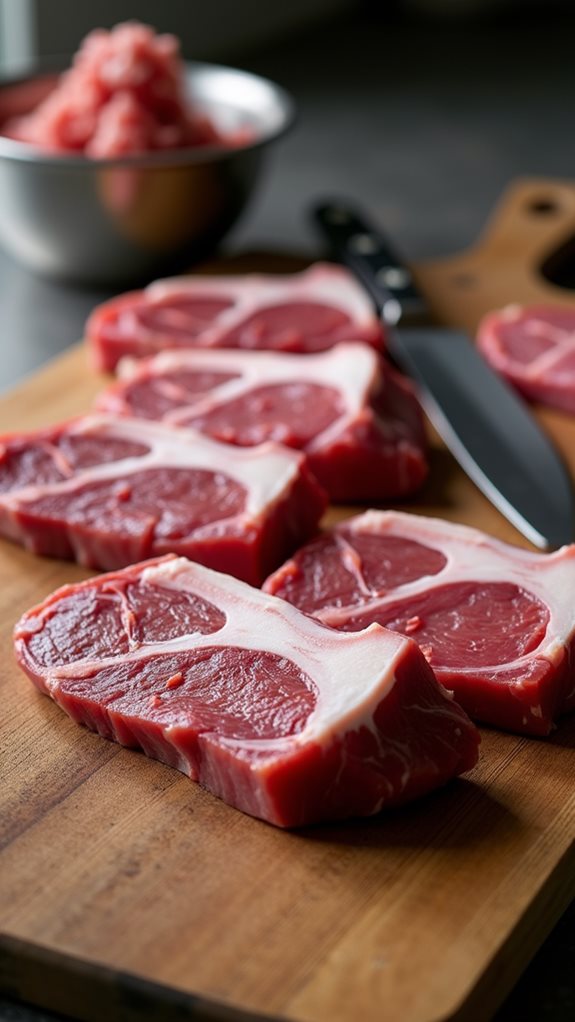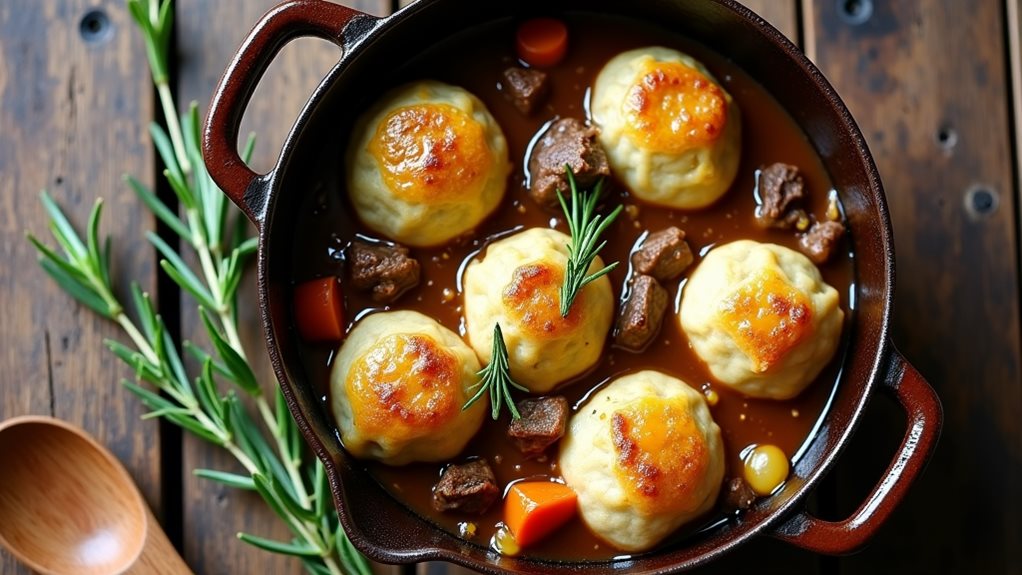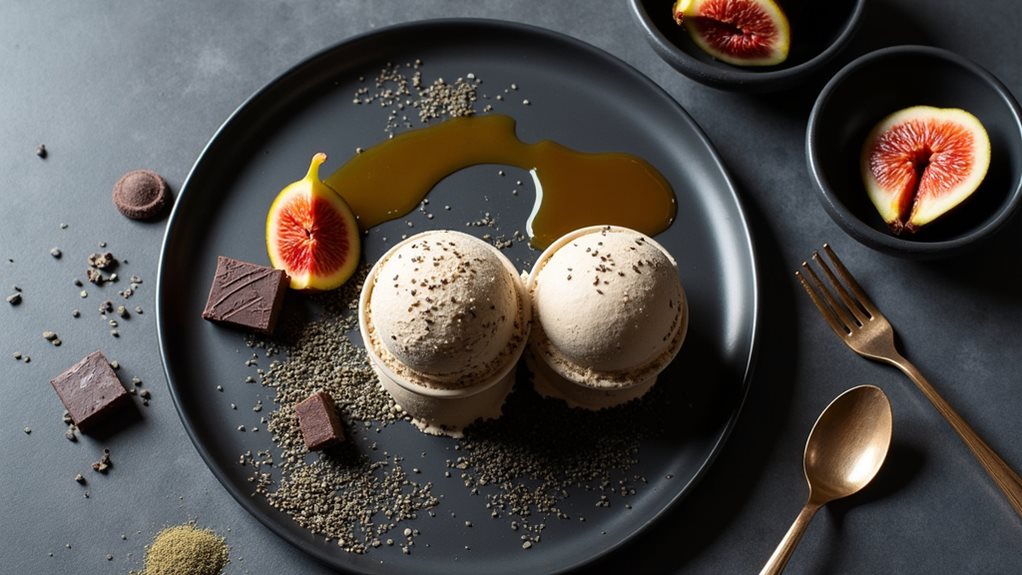Picture yourself at an old Irish pub in County Kerry, where the locals have gathered for their weekly Sunday feast. You'll notice steaming bowls of rich lamb stew making their way to weathered wooden tables, topped with pillowy dumplings that have soaked up the aromatic broth below. This centuries-old comfort food has evolved from a peasant's sustenance to a celebrated dish that combines tender meat, garden vegetables, and cheese-studded dumplings into one satisfying pot. Whether you're an experienced cook or a curious novice, there's more to this hearty meal than meets the eye.
Key Takeaways
- Create savory dumplings by combining self-rising flour with grated sharp cheddar cheese and finely chopped fresh rosemary.
- Drop golf ball-sized portions of dumpling dough onto simmering lamb stew, leaving space for expansion during cooking.
- Cook dumplings covered for 15-20 minutes without lifting the lid, ensuring they become light and fluffy.
- Brown lamb thoroughly in batches before slow-simmering with vegetables for 1.5-2 hours until tender.
- Maintain gentle heat when cooking dumplings, allowing them to rest on the stew's surface without submerging.
History
Lamb stew with dumplings traces its roots to traditional Irish and British farmhouse cooking, where hearty one-pot meals helped sustain workers through long days in the fields.
You'll find that this dish emerged during times when families needed to make the most of available ingredients, combining tougher cuts of meat with root vegetables and flour-based dumplings to create filling, economical meals.
In the 18th and 19th centuries, you'd have seen this dish evolve as cast-iron cooking pots became more common in rural households.
The dumplings, which you'll recognize as fluffy bread-like additions to the stew, were originally developed as a way to stretch meals further using simple ingredients like flour, fat, and herbs.
You can trace similar versions of this comfort food across numerous Celtic and Anglo-Saxon communities, where sheep farming was prevalent.
Today's versions often include ingredients that weren't readily available to your ancestors, such as tomato paste and various spices, but the fundamental cooking method hasn't changed much.
You're still creating the same soul-warming dish that's been filling bellies for generations.
Recipe
Lamb stew with dumplings is a hearty, traditional dish that combines tender chunks of lamb with root vegetables in a rich, savory gravy, all topped with fluffy, cloud-like dumplings. This one-pot meal brings together the best of comfort food traditions, creating a warming dish perfect for cold weather dining.
This classic recipe takes time to develop its deep flavors, as the lamb slowly tenderizes and the vegetables meld together in the gravy. The dumplings, added near the end of cooking, soak up the flavorful broth while maintaining their light, pillowy texture, making this dish a complete meal that satisfies all comfort food cravings.
Ingredients:
- 2 lbs (900g) lamb shoulder, cut into 1.5-inch cubes
- 3 medium carrots, chopped
- 2 celery stalks, chopped
- 2 medium onions, diced
- 2 cloves garlic, minced
- 4 medium potatoes, quartered
- 2 tablespoons tomato paste
- 4 cups (950ml) beef broth
- 2 bay leaves
- 1 sprig fresh rosemary
- 2 tablespoons vegetable oil
- Salt and pepper to taste
For the dumplings:
- 2 cups (250g) all-purpose flour
- 1 tablespoon baking powder
- 1/2 teaspoon salt
- 3 tablespoons cold butter
- 3/4 cup (180ml) cold milk
Season and brown the lamb in batches in a large Dutch oven, then remove and set aside. Sauté vegetables until softened, return meat to pot with remaining ingredients, and simmer covered for 1.5 hours.
Mix dumpling ingredients until just combined, drop spoonfuls onto simmering stew, cover, and cook for 20 minutes until dumplings are puffed and cooked through.
For best results, ensure the stew maintains a gentle simmer throughout cooking, as boiling can toughen the meat. The dumplings should rest on top of the stew without being submerged, and the pot shouldn't be opened while they cook.
If the stew seems too thin, simmer uncovered for 10-15 minutes before adding dumplings. The dish can be made a day ahead (without dumplings) and reheated before adding fresh dumplings just before serving.
Cooking Steps
You'll start by trimming excess fat from the lamb and browning the meat in batches until it develops a rich, golden crust.
Next, you'll sauté your vegetables in the same pot until tender, then add broth and let everything simmer until the meat becomes fork-tender.
During the final 20 minutes of cooking, you'll drop spoonfuls of dumpling dough onto the simmering stew, allowing them to steam and puff up into light, fluffy dumplings.
Step 1. Trim Fat From Meat

Before starting the stew, carefully trim away any visible fat from the lamb pieces using a sharp knife.
You'll want to focus on removing the thick, white sections of fat along the edges and any marbling that's easily accessible. While some fat adds flavor, too much can make your stew greasy and less enjoyable.
Place each piece of lamb on a clean cutting board and hold it firmly with one hand while using your knife at an angle to separate the fat from the meat.
You'll find it's easier to trim when the meat is slightly chilled rather than at room temperature. Don't worry about getting every tiny bit of fat, as a small amount will contribute to the rich flavor of your finished stew.
For shoulder cuts, pay special attention to the connective tissue and silvery membrane, which can become tough during cooking.
If you're working with lamb leg pieces, look for the layer of fat that often runs along the outside edge.
Once you've trimmed all the pieces, discard the fat and give your meat a quick rinse under cold water before patting it dry with paper towels.
Step 2. Brown Meat in Batches

To achieve the perfect sear, work with small batches of lamb when browning the meat. Heat your large, heavy-bottomed pot over medium-high heat, then add a tablespoon of oil, letting it shimmer before adding the first batch.
You'll want to leave plenty of space between the meat pieces, as overcrowding will cause them to steam rather than brown. Place the lamb chunks in a single layer, and don't disturb them for about 3-4 minutes until they've developed a rich, golden-brown crust.
Once you've achieved that beautiful color on one side, turn each piece to brown the remaining sides. You'll know you're doing it right when you hear a steady sizzle and see caramelization forming on the meat's surface.
Remove each batch with a slotted spoon and set aside on a plate while you continue with the remaining meat. Between batches, you might need to add a little more oil if the pot becomes too dry.
Don't rush this process – proper browning typically takes about 20-25 minutes total, but it's essential for developing the deep, complex flavors that make your stew extraordinary.
Step 3. Sauté Vegetables Until Tender

Once the meat is set aside, add diced onions, carrots, and celery to the same pot, using the flavorful fond left behind from browning.
You'll want to cook these aromatics over medium heat for 8-10 minutes, stirring occasionally until the vegetables have softened and the onions become translucent. The vegetables will gradually release their natural moisture, helping to loosen those precious browned bits from the bottom of the pot.
Add minced garlic and cook for another minute until fragrant, being careful not to let it burn.
Next, stir in two tablespoons of tomato paste and cook for an additional 2-3 minutes, allowing it to coat the vegetables and slightly caramelize. This step develops a deeper, richer flavor base for your stew.
If you notice the vegetables starting to stick to the bottom, you can add a splash of water or wine to deglaze the pot. The goal is to achieve tender, lightly caramelized vegetables that'll form the backbone of your stew's flavor profile.
Once the vegetables are properly sautéed, you're ready to move on to building the stew's liquid base.
Step 4. Add Broth and Simmer

After your vegetables are perfectly tender, pour in 4 cups of rich beef broth and return the browned lamb to the pot.
Add 2 tablespoons of tomato paste, 1 tablespoon of Worcestershire sauce, and a generous pinch of dried thyme. You'll want to stir everything thoroughly to ensure the tomato paste dissolves completely into the broth.
Bring the mixture to a gentle boil, then reduce the heat to maintain a steady simmer. Cover the pot partially with its lid, leaving about an inch gap for steam to escape.
You'll need to let the stew simmer for approximately 1½ to 2 hours, or until the lamb becomes fork-tender and easily pulls apart. During this time, you'll notice the liquid reducing and the sauce thickening naturally.
Check the stew every 30 minutes, giving it a gentle stir to prevent any sticking on the bottom. If you find the liquid reducing too quickly, add an extra ½ cup of broth or water.
Once the meat is tender, taste and adjust the seasoning with salt and freshly ground black pepper as needed.
Step 5. Add Dumplings During Cooking

The dumpling-making process begins when your stew reaches the final 20 minutes of cooking time.
In a medium bowl, combine 2 cups of self-rising flour, 1/2 cup of grated sharp cheddar cheese, and 2 tablespoons of finely chopped fresh rosemary.
Using your fingertips, work 3 tablespoons of cold butter into the flour mixture until it resembles coarse breadcrumbs.
Gradually add 3/4 cup of cold milk to the flour mixture, stirring with a wooden spoon until you've formed a soft, slightly sticky dough.
Don't overmix, as this will result in tough dumplings.
Using two spoons, drop golf ball-sized portions of the dumpling dough onto the surface of your simmering stew, leaving space between each one as they'll expand during cooking.
Cover the pot with a tight-fitting lid and continue cooking for 15-20 minutes, or until the dumplings have puffed up and are cooked through.
You'll know they're ready when a skewer inserted into the center comes out clean.
Don't lift the lid during cooking, as the steam is essential for creating light, fluffy dumplings.
Final Thoughts
Preparing this classic lamb stew with dumplings takes time and patience, but you'll find the end result deeply satisfying. As you serve the steaming bowls of tender meat, vegetables, and fluffy dumplings, you'll appreciate how each component contributes to this hearty, soul-warming meal.
Don't be discouraged if your first attempt isn't perfect – mastering this dish requires practice. You'll learn to recognize when the meat is perfectly tender and develop an instinct for the ideal dumpling consistency.
If you're planning to serve this at a gathering, you can prepare the stew base a day ahead, then reheat and add the dumplings just before serving. This approach actually enhances the flavors, as they'll have more time to develop.
Remember to store any leftovers in an airtight container in the refrigerator, where they'll keep for up to three days. You may find the dumplings will absorb more of the gravy overnight, creating an even richer texture.
When reheating, add a splash of broth or water to achieve your desired consistency, and warm gently to avoid toughening the meat.















